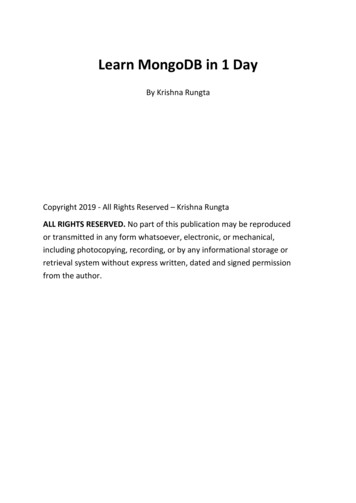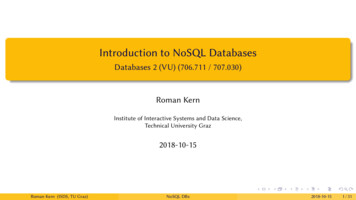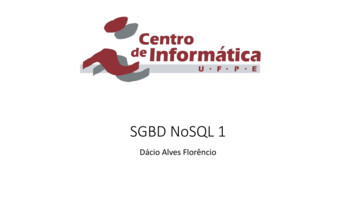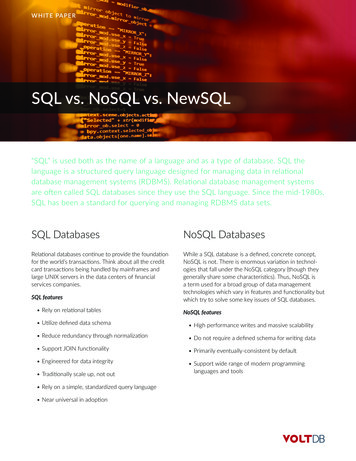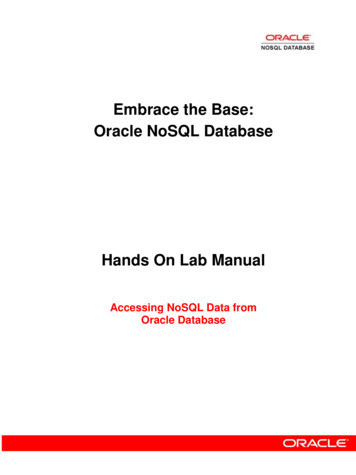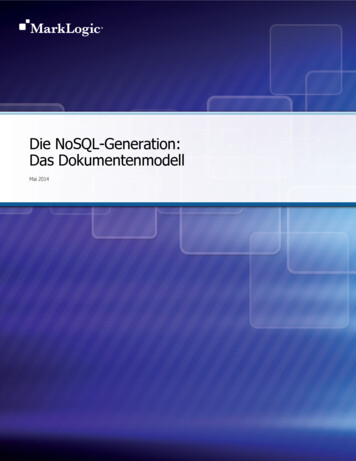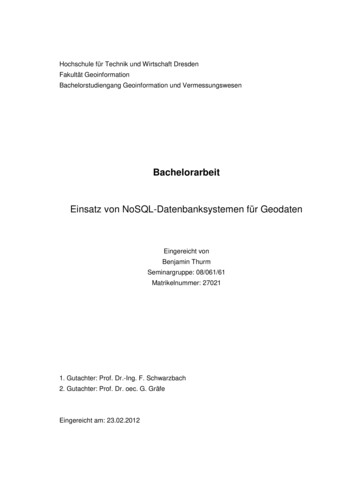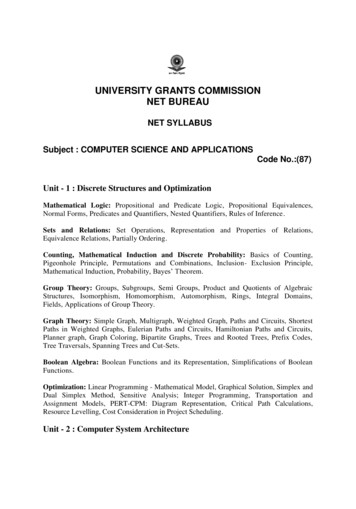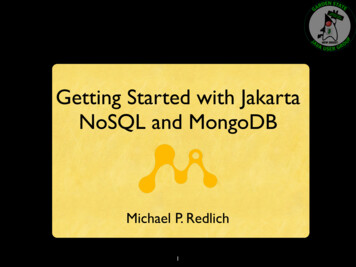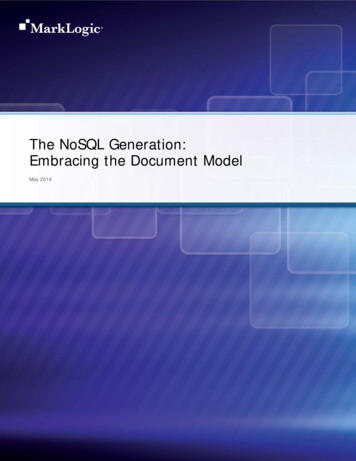
Transcription
The NoSQL Generation:Embracing the Document ModelMay 2014
Table of ContentsIntroduction 3The History of “NoSQL” 3Types of NoSQL Databases 4Embracing the Document Model 7Defining Enterprise NoSQL 10
IntroductionNoSQL databases are a new generation of databases that have gained significant market traction becausethey solve major challenges with the volume, variety, and velocity of big data. NoSQL represents afundamental change in thinking about how data is stored and managed that is counter to the relationaldatabase approach used for Oracle Database 12c, Oracle MySQL, Microsoft SQL Server, IBM DB2, Postgres,and many others. 1The term “NoSQL” is a broad descriptor covering a wide range of new databases, generally broken downinto four main categories: document, key-value, column-family, and graph databases. Among thesecategories, document databases are the best general purpose databases. Document databases have a morelogical, human approach to modeling data, are generally the most flexible and easy to use, and are themost popular.Among document databases, MarkLogic differentiates itself as an “Enterprise NoSQL” database because inaddition to qualifying as a NoSQL database, it has all of the critical features that enterprises need to runmission-critical applications. This means ACID transactions, high availability, disaster recovery, governmentgrade security, elasticity and scalability, and performance monitoring tools. With MarkLogic, enterprises canembrace the document model and securely move forward into the next era of databases.The History of “NoSQL”MarkLogic is now known as an Enterprise NoSQL database, but was originally known mostly for its ability tostore and search XML. The original patent filings in 2002 had to do with a new way of storing data using theXML tree structure, including a new way to query that data. These patents were filed by MarkLogic’sfounder Christopher Lindblad long before anyone coined the term NoSQL. MarkLogic has since adopted theterm “NoSQL” as a broad descriptor, also adding the “Enterprise” part to differentiate it from the many newdatabases invented more recently that have not yet evolved to include enterprise features.The term “NoSQL” has only been in use since 2009, just five years ago. The term was initially chosen as atwitter hashtag to promote a meetup group to discuss new database technologies in San Francisco. Themeetup was organized by Johan Oskarsson, a developer visiting from London, and the term was suggestedby Eric Evans, a developer at Rackspace. The term was meant to only have a short lifespan, but it quicklycaught on. With the explosion of new databases such as Cassandra, MongoDB, and CouchDB that followed1Gartner, “Hype Cycle for Big Data, 2013”, July 31, 2013.MarkLogic CorporationThe NoSQL Generation: Embracing the Document Model3
in the wake of Google’s Bigtable and Amazon’s Dynamo, the market needed a term to describe the newtechnologies. 2One of the big misconceptions is that the term NoSQL means “No SQL”, and that NoSQL databases do notuse SQL (structured query language) as a query language. But, many NoSQL databases do use SQL, oftenas one option among many supported query languages. For example, MarkLogic supports Java, SQL,XQuery, and SPARQL. For this reason, NoSQL is now generally referred to as “Not Only SQL.” Despite thefact that NoSQL does a better job at describing what it is not rather than what it is, the term is still veryuseful for describing a broad class of databases ideally suited for the data problems we deal with today.Types of NoSQL DatabasesNoSQL databases handle the volume, variety, and velocity of big data very well. But, they each handle thosethree V’s very differently depending on their data model. For this reason, NoSQL databases are groupedaccording to their data model, and include document, key-value, column family, and graph databases.MarkLogic is a document database but can also store RDF triples (a feature called semantics), which givesMarkLogic some graph database capabilities.Document DatabasesSometimes called “document stores” or “aggregate databases,” document databases use documents as thecentral entity for storage and queries. The term “document” does not necessarily mean a PDF or MicrosoftWord document. The document can also be a single block of XML or JSON. An XML document does notFigure 1: MarkLogic is a document database that can store XML, JSON, text, and large binariessuch as PDFs and Microsoft Office documents2Fowler, Martin. N oSQL Distilled . Pearson Education, Inc. 2013.MarkLogic CorporationThe NoSQL Generation: Embracing the Document Model4
require pre-defined fields and it can also store nested data, often taking on a distinctive tree-like structurethat can be queried. Document databases are ideal for storing large amounts of text information such asbooks or publications, though they can also be used for storing a wide variety of other types of informationsuch as financial data, patient records, or metadata. Put another way, a document could contain all of theinformation that you would find in the row of a relational table. Because of their flexibility, documentdatabases are the most popular kind of NoSQL database.Key-Value DatabasesKey-value databases have the simplest data model among NoSQL databases—they use a searchable indexkey associated with a value. Relational key-value databases have been around for many years, but thenewer key-value databases fall into the NoSQL category because they are purpose-built for speed and scaleby sacrificing some functionality. For example, there are generally no alternate keys and no foreign keys, noimplicit ordering, and no text searching capabilities against the values. These databases are often used forcaching website visits and one of the more popular key-value databases, memcache, is named specificallyfor this purpose. Other uses include storing user preference settings for an application or storing largestreams of non-transactional data.Column Family DatabasesA column family database is similar in theory to a table in a relational database, except that it can scale tozillions of rows, and each row can have any number of columns. Each column family associated with a row(i.e., a column family) consists of a key-value pair (a column key and a column value).Column families became well-known after Google published their Bigtable paper, and has been spurred onby the popularity of Cassandra and HBase. Popular uses for column family databases are for applicationevent monitoring, content management systems, and blogging platforms. Column family stores are not thebest choice when ACID transactions are required or when queries are complex or changing.Figure 2: Column family databases such as Cassandra organize data by a row key that isassociated with any number of columnsMarkLogic CorporationThe NoSQL Generation: Embracing the Document Model5
Graph DatabasesGraph databases focus on the relationships between the data, which is why graph data is often referred toas “linked data.” Data points are called nodes, and the relationship between one data point and another iscalled an edge. These relationships make graph databases ideal for social media sites such as LinkedIn,Facebook, and Twitter where questions are asked about “degrees of separation” between people.One way to store linked data is with a distinct kind of graph database called an “RDF triple store.” RDFstands for Resource Description Framework, and a triple is the combination of a subject, predicate, andobject – for example, “Bo [subject] knows [predicate] baseball [object].” There are a few subtle butimportant differences between RDF triple stores and general purpose graph databases.Graph DatabasesRDF Triple StoresExamplesNeo4j, Titan, OrientDBMarkLogic, AllegroGraph, SesameTypes of Data StoredUnlabeled graphs, undirected graphs, weightedgraphs, hypergraphsRDF triplesQuery Language(s)Cypher, G, GraphLog, GOOD, SoSQL, BiQL, SNQL,and moreSPARQLOther AttributesOptimized for graph traversalsGraph traversals can be slowCannot do inferencing (i.e., does not infer newtriples based on existing data)Can do inferencing (e.g., if humans are a subclass ofmammals and man is a subclass of humans, then itcan be inferred that man is a subclass of mammals)MarkLogic has semantic web capabilities and graph database characteristics because it can store RDF triplesand query them using SPARQL. The example below illustrates how MarkLogic Semantics can be used tocreate an interactive visualization—a distinguishing feature made possible with linked data.Figure 3: FactGem is an application that uses MarkLogic semantics to show associations such asinvestment relationships among venture capitalistsMarkLogic CorporationThe NoSQL Generation: Embracing the Document Model6
Embracing the Document ModelDocument databases are the most popular type of NoSQL databases because they are both powerful andflexible enough to serve as a general purpose database. Although MarkLogic does have some graphdatabase capabilities, at its core it is a document database. This has proved to be the right directionbecause it is much easier to add graph capabilities to a document database than the other way around. Thefive main reasons to embrace MarkLogic’s document model are below.A More Logical and Human StructurePeople naturally organize information using hierarchies and groupings—the structure of documents. This isevident even in industries such as financial services or healthcare where one would think data is alwaysstructured. Derivative trades and health data can be easily modeled as documents. And yet, we tried foryears to shred this data into relational schemas that no one could agree on. The document model makes iteasier to understand what the data is about from a human perspective, and fortunately, MarkLogic alsomakes it easy to understand from a computer’s perspective.For a deeper look at how MarkLogic takes a new approach to data modeling, watch the presentation, DataModeling in NoSQL with XML, RDF, and JSON.Schema-Agnostic, Structure AwareDocument databases are schema-agnostic but they can enforce a schema when needed because they arealso structure-aware. Investment banks frequently need to enforce schemas when handling financialtransactions. But, if the bank decides down the road that the schema needs to change, it is a change thatcan be done rather rapidly. This approach—having schema when you need it—is a huge change from therelational world where it might take months of work to manage changes to schema design.When it comes to loading data, not much has to be known about the data before loading. It helps if youknow how you will structure your queries, because this may impact the primary ID’s that are given to agroup of documents, but it is not an absolute requirements. With MarkLogic, data is indexed and can bequeried immediately after ingesting, regardless of the schema.All of the data within a document is self-contained and does not rely on data in other documents within thedatabase. This means no foreign keys, and no normalization. Because each document is self-contained, it iseasy to distribute data across clusters, making it trivial to setup a cluster and scale a document database.With MarkLogic, you can standup or take down a cluster in the cloud in just a few minutes. The documentMarkLogic CorporationThe NoSQL Generation: Embracing the Document Model7
model also enhances performance because a group of documents can appear as a contiguous set ofcontent for querying on-disk.For a deeper look at how MarkLogic handles legacy schemas for investment banks, watch thepresentation, Schema on Read in Financial Services.Easy Application DevelopmentIt is not surprising that developers are usually the champions of NoSQL within most IT departments. NoSQLsimplifies their lives. The greatest benefit is the time savings from not having to do relational modeling onunstructured information, or on aggregated multistructured data. The document model, in particular,saves time because data is often already in adocument format as XML or JSON.For example, Founder’s Online, an application built bythe University of Virginia Press in collaboration with theNational Archives, contains almost 150,000 searchabledocuments that were tagged with XML and then loadedto MarkLogic. This application was created by twodevelopers in a number of months and achievesserious scale, supporting 120ms response times withfive thousand concurrent users. 3Figure 4: Founder's Online, a powerfulsearch app built by two developersDevelopers also favor the document model because it plays well with the languages that developers love—PHP, Ruby, and JavaScript—which are primarily object-based. It is easy to think of the object as thedocument with these languages. When documents are stored natively as JSON in the database, it is it ispossible to use JavaScript and JSON in the database, server, and on the client in the front-end. Thatsimplicity means data does not have to be transformed when moving between tiers, which reduces theworkload on the server and makes development much smoother. This simplicity also creates flexibilitybecause the application and business logic can be put in any tier. If a mistake is made, the expense ofchanging it later on is minimal.For a deeper look at one company’s fast approach to developing applications with MarkLogic, watch thepresentation, Building Applications on MarkLogic Fast and Easy.3For more information, watch the presentation, Planning For Growth With and Without Performance Metering, deliveredby David Sewell, Editorial and Technical Manager at University of Virginia Press.MarkLogic CorporationThe NoSQL Generation: Embracing the Document Model8
Advanced SearchOne of the major drawbacks of more simplistic NoSQL databases like key-value stores is that queries usuallyonly apply to the primary key. In a document database, queries apply to all of the data, including thedocument ID and the document’s contents. Document databases can also rely on indexes to support search.MarkLogic has almost 30-different indexes that can be toggled on-and-off to provide a rich and customizablesearch experience, including faceted search and real-time alerting. These search features were built-in toMarkLogic from the start, and in fact, MarkLogic’s founder has a deep background in search: ChristopherLindblad was the architect of Ultraseek Server.MarkLogic also supports numerous other search features including word and phrase search, Boolean search,proximity, wildcarding, stemming, tokenization, de-compounding, case-sensitivity options, punctuationsensitivity options, diacritic-sensitivity options, document quality settings, numerous relevance algorithms,individual term weighting, topic clustering, faceted navigation, and custom-indexed fields.These many features are made possible by MarkLogic’s use of the document model, but only MarkLogic hassearch built-in. Other document databases must rely on bolt-on technology like Lucene or Solr to providesearch capabilities, which adds complexity to the technology stack. Another differentiator is that documentscan be searched immediately upon loading them into MarkLogic when their contents are indexed.For a deeper look at how MarkLogic conquers database search, watch the presentation, Search, Relevance,and Context: Getting the Most out of MarkLogic Search.Enormous Variety of Potential Use CasesEnterprise-grade document model databases are flexible and powerful enough to serve as a generalpurpose database for an enormous variety of use cases. MarkLogic is a perfect fit anytime there is a need toeliminate data silos, use a single platform for search and analytics, reduce storage costs, better secure data,or develop an application faster. This applies to almost any industry, from media and publishing to financialservices and healthcare: Media and Publishing: This industry was the first to adopt document databases. One largepublisher, LexisNexis, was the first MarkLogic customer and continues to use MarkLogic today.Another publisher, Wiley, has used MarkLogic to consolidate 4 Million articles, 9,000 books, andthousands of reference works. They gained a 50% growth in usage, and after strategic acquisitionsof content libraries, were able to quickly absorb and monetize that new material. Financial Services: Investment banks require strong governance policies, and need to respondquickly to regulators. A tier-1 bank had trouble developing risk profiles and conducting post-tradereporting because of the disparate heterogeneous data sources in legacy mainframes and SybaseMarkLogic CorporationThe NoSQL Generation: Embracing the Document Model9
databases. But, with MarkLogic, they were able to bring that data into a single system, helpingthem save millions of dollars in IT costs and respond faster to regulators. Healthcare: Healthcare is another regulated industry that struggles to manage the variety ofdata, and is squeezed by tightening margins and government oversight. One MarkLogic customer,Zynx Health, partners with different hospitals across the United States to provide personalizedplans of care. Despite the challenge of partnering with over 2,000 hospitals, they were able to buildan application in less than a year that each of those hospitals now relies on to improve care qualityand meet meaningful use requirements. Government: Government agencies love documents. But, when budgets get squeezed and thepressure mounts to move services online, they frequently run into the problem of developingapplications in a timely and efficient manner. Government agencies are also wary of getting lockedinto building an entirely new system or replicating their data again and again for each newapplication—and of course they have serious data security needs. MarkLogic has helped solve thisproblem for the FAA, CMS, FDA, DoD, and the intelligence community.While relational databases and other types of NoSQL databases will continue to serve specific purposes,document databases such as MarkLogic will help solve the most pressing big data challenges organizationsface today.To learn more about the many potential opportunities to use MarkLogic, watch the presentation, Reimagine:Data, Applications with MarkLogic.Defining Enterprise NoSQLThere is a misconception that NoSQL is not for serious applications—that NoSQL is just for startups, or justa place for businesses to put their non-critical data. As the examples above illustrate, that is simply not trueanymore. “Enterprise NoSQL” means a database that has the ability to handle the volume, variety, andvelocity of data like all NoSQL solutions, AND has the necessary features to run at the heart of the business.Unless a NoSQL solution has the following features, it is not enterprise grade, and should not be used formission critical applications: ACID Transactions: ACID transactions are not just for banking. Without ACID transactions(atomicity, consistency, isolation, durability), there is also a high probability of data loss. And, if thenetwork fails for any reason, the result can be catastrophic for the database. Enterprises needsupport for multi-record transactions and rich, multi-term queries—additional features madepossible with ACID transactions. High Availability and Disaster Recovery: Organizations should not have to implement entirelynew procedures and governance structures to manage data in a NoSQL database. Enterprises needHigh Availability (HA) with local disk automatic failover, point-in-time recovery, and asynchronousMarkLogic CorporationThe NoSQL Generation: Embracing the Document Model10
cross data center replication for Disaster Recovery (DR). This is necessary so that if the data centerdoes go down, data is not lost and the database does not have to be rebuilt. Government Grade Security: It is not just governments that need security. The risk of notsecuring data is simply too high, which is why, according to Gartner, investment in IT security willincrease by around 39%, to 93 billion, by 2017. Government grade security means having a topcertification from the National Information Assurance Partnership (NIAP) Common CriteriaEvaluation and Validation Scheme (CCEVS) for supporting key security functions such as audits,user data protection, security management, data protection, TOE (target of evaluation) access, andidentification and authentication (including third-party support for LDAP and Kerberos). Elasticity and Scalability: Enterprises should be able to scale up or down in minutes to meetdata volume and access demands, while also avoiding over-provisioning and over-spending. Thisneeds to be done without downtime, inconsistency, or risk of data loss. The database should runeasily on Amazon Web Services or other Cloud providers but should also have flexibility fordeployment in other virtualized environments or on premises. Monitoring and Performance Tools: Great tools for monitoring and management ensure thatthe IT team is just as happy with the platform choice as the developers. Enterprises needautomatic rebalancing and cluster monitoring tools and rich APIs for management, processautomation, access controls, database cloning, and audit trails. They also need out-of-the-boxinterfaces that link to common tools such as Nagios and HP OpenView.MarkLogic is built from the ground up to include all of these features, and continues to focus on buildingenterprise features that no other NoSQL solution has. If you are interested in learning more, you can findadditional resources online at MarkLogic.com. In particular, you can take a deeper dive by reading the whitepaper, Inside MarkLogic.If you want to talk to us about installing MarkLogic in your organization, give us a call at 1-877-992-8885,or email a sales representative at sales@marklogic.com.MarkLogic CorporationThe NoSQL Generation: Embracing the Document Model11
About MarkLogicFor more than a decade, MarkLogic has delivered a powerful, agile, and trusted Enterprise NoSQL databaseplatform that enables organizations to turn all data into valuable and actionable information. Organizationsaround the world rely on MarkLogic’s enterprise-grade technology to power the new generation ofinformation applications. MarkLogic is headquartered in Silicon Valley with offices in Washington D.C., NewYork, Chicago, London, Frankfurt, Utrecht, and Tokyo. For more information, please visitwww.marklogic.com. 2014 MarkLogic Corporation. All rights reserved. This technology is protected by U.S. PatentNo. 7,127,469B2, U.S. Patent No. 7,171,404B2, U.S. Patent No. 7,756,858 B2, and U.S. Patent No7,962,474 B2. MarkLogic is a trademark or registered trademark of MarkLogic Corporation in the UnitedStates and/or other countries. All other trademarks mentioned are the property of their respective owners.[SS-MLIH-13-06]999 Skyway Road, Suite 200, San Carlos, CA 94070 › US: 1 650 655 2300 › INT'L.: 1 877 992 8885sales@marklogic.com › www.marklogic.comMarkLogic CorporationThe NoSQL Generation: Embracing the Document Model12
NoSQL databases are a new generation of databases that have gained significant market traction because they solve major challenges with the volume, variety, and velocity of big data. . Fowler, Martin. NoSQL Distilled . Pearson Education, Inc. 2013. Figure 1: MarkLogic is a document database that can store XML, JSON, text, and large binaries


